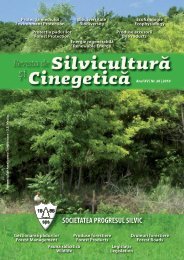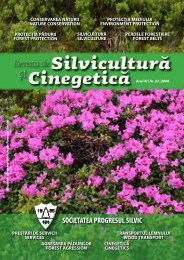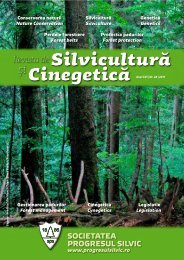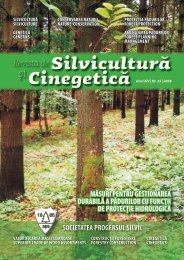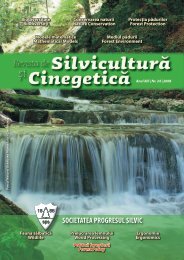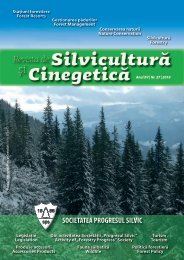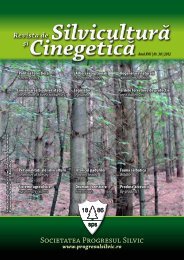Silviculture and Cinegetics Review - Societatea Progresul Silvic
Silviculture and Cinegetics Review - Societatea Progresul Silvic
Silviculture and Cinegetics Review - Societatea Progresul Silvic
Create successful ePaper yourself
Turn your PDF publications into a flip-book with our unique Google optimized e-Paper software.
FORESTRY POLICY SILVICULTURE AND CINEGETICS REVIEW XVII/30/2012<br />
This requires that we recognize today that our forests<br />
have been formerly 70 or 75% occupied by farmers.<br />
We have now in metropolitan France 16 million<br />
hectares of forests, while at the end of the First<br />
Empire, the woodl<strong>and</strong>s were reduced to 7 or 8 million<br />
hectares, as a result of l<strong>and</strong> clearing that occurred<br />
during the Revolution, after the departure abroad of<br />
nobles loyal to the monarchy <strong>and</strong> sale as national<br />
property of the church l<strong>and</strong>s. 8 million hectares of<br />
forests today are former agricultural l<strong>and</strong> <strong>and</strong> half of<br />
the rest has been in the 4th or 5th century.<br />
In Guyana it is the research undertaken by INRAP<br />
(National Institute for Preventive Archaeological<br />
Research), which helped find many signs of human<br />
presence in the forest called virgin (Dambrine et<br />
Jérémie, 2010). These are very special soils, black <strong>and</strong><br />
containing numerous fragments of pottery. These are<br />
the terra firme found mainly on river banks. They<br />
clearly confirm the first descriptions, by Francisco de<br />
Orellana who went down the Amazon in the mid<br />
sixteenth century, of large villages extending over<br />
several kilometers, but that disappeared quickly,<br />
villagers being driven out by the Spanish or<br />
Portuguese conquerors or decimated by epidemics<br />
brought by Europeans. But there are many more<br />
convincing facts. We identified over 1,800 sites<br />
within the Guyanese forest where human presence is<br />
attested by the former presence of post holes,<br />
fragments of pottery, fragments of rock, <strong>and</strong> remains<br />
of workshops of shaping tools or of game cutting.<br />
More spectacular still, barred spurs, hills or<br />
promontories around which were dug deep trenches<br />
several meters wide, defensive sites, therefore at the<br />
center of which must have existed permanently<br />
occupied villages.<br />
This leads gradually to the idea of a forest heavily<br />
inhabited by Native Americans, permanently at least<br />
in some cases. This occupation may have played a<br />
role in the distribution of tree species, some more<br />
dem<strong>and</strong>ing or more light-dem<strong>and</strong>ing coming to<br />
reoccupy plots cleared for agriculture.<br />
We must therefore conclude that, in regions where we<br />
just mentioned, forests at all times untouched by<br />
human activity are rare. The human occupation has<br />
left traces still identifiable on soil properties <strong>and</strong><br />
composition of the herbaceous flora, probably also on<br />
the distribution of shrubs <strong>and</strong> trees. It is likely that the<br />
same applies in many areas where such signs are just<br />
waiting for the discoverers.<br />
Bibliography<br />
Dambrine E., Dupouey J.L., 2006: La mémoire des forêts.<br />
ONF, Rendez-vous techniques, n° 11, 45-50.<br />
Dambrine E. Dupouey J.L., Laut L., Humbert L.,<br />
Thinon M., Beaufils T., Richard H., 2007: Present<br />
forest biodiversity patterns in France related to former<br />
roman agriculture. Ecology, 88 (6), 1430-1439.<br />
Dambrine E., Jérémie S., 2010: Groupe couac. – Une<br />
forêt vierge par nature La fin d’un mythe. In : La forêt<br />
de Guyane française. M. Bonneau, l’Harmattan, Paris,<br />
331 p.<br />
Jussy J.H., Körner W., Dambrine E., Dupouey J.L.,<br />
2002: Benoît M. – Influence of former` agricultural l<strong>and</strong><br />
use on net nitrate production in forest soils. Euroean<br />
Journal of Soil Science, 53, 367-374.<br />
Prévosto B., Dambrine E., Moarès C., Curt T., 2004:<br />
Effects of volcanic ash chemistry <strong>and</strong> former agricultural<br />
use on the soil <strong>and</strong> vegetation of naturally regenerated<br />
woodl<strong>and</strong>s. Catena, 56, 239-261.<br />
Abstract.<br />
Recent work in metropolitan France <strong>and</strong> in French Guiana shows that most of the forests were previously agricultural<br />
cropl<strong>and</strong>s or pastures.<br />
In the book of 1905, ‘Forest Soils’ of the pedologist Henry he states that ammonium nitrification was always zero in the<br />
forest. This statement would contradict the active nitrification found in the majority of research conducted in soils in the<br />
Vosges or the Massif Central.<br />
The answer to this problem was found in late 1980 when Etienne Dambrine discovered that st<strong>and</strong>s unaffected by the drying<br />
(loss of their leaves or needles or yellowing) were located on plots of agricultural l<strong>and</strong> previously used for crops or grazing<br />
animals. Moreover soils of these plots were the site of an active nitrification unlike areas where they found traces of human<br />
occupation. Subsequently, this was confirmed by laboratory incubation (Jassy, 2002). So Henry, a graduate of the Forest<br />
School of Nancy, used perfectly accurate methods to characterize the nitrates, but collected soil samples from st<strong>and</strong>s of<br />
beech <strong>and</strong> fir <strong>and</strong> not spruce plantations installed on old agricultural plots in the second half of the nineteenth century with<br />
10,000 stems per hectare, which at that time were 20-30 years old.<br />
In these forests of beech <strong>and</strong> fir Henry (1905) as well as Dambriene Etienne (1980) found no nitrates.<br />
The same author, Etienne Dambriene using a Lidar device, loaded on a plane concluded that a large part of the grove of oak<br />
<strong>and</strong> hornbeam from Haye has been used extensively in the historical past by farmers. Soil analysis reveals a lower C / N<br />
ratio <strong>and</strong> is richer in phosphorus, the forests with agricultural use traces than in forests that have always existed.<br />
12



